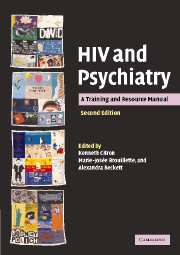Book contents
- Frontmatter
- Contents
- List of contributors
- Preface
- 1 Medical overview
- 2 Cognitive disorders in people living with HIV disease
- 3 General principles of pharmacotherapy for the patient with HIV infection
- 4 Mood disorders and psychosis in HIV
- 5 Suicidal behavior and HIV infection
- 6 Anxiety disorders and HIV disease
- 7 General issues in hospital HIV psychiatry
- 8 HIV and people with serious and persistent mental illness
- 9 Psychotherapy
- 10 HIV and substance use disorders
- 11 Psychiatric issues in pediatric HIV/AIDS
- 12 Uninfected children of parents with HIV
- 13 Psychological issues faced by gay men
- 14 Women and HIV
- 15 Couples
- 16A HIV and cultural diversity
- 16B African Americans
- 16C Latinos and HIV disease
- 16D One heart, two spirit, and beyond: HIV and the people of the First Nations
- 17 HIV in prison populations
- 18 Legal and ethical issues
- 19 Psychiatrist as caregiver
- Appendix I HIV Counselling checklist for physicians
- Index
- References
16C - Latinos and HIV disease
Published online by Cambridge University Press: 06 August 2009
- Frontmatter
- Contents
- List of contributors
- Preface
- 1 Medical overview
- 2 Cognitive disorders in people living with HIV disease
- 3 General principles of pharmacotherapy for the patient with HIV infection
- 4 Mood disorders and psychosis in HIV
- 5 Suicidal behavior and HIV infection
- 6 Anxiety disorders and HIV disease
- 7 General issues in hospital HIV psychiatry
- 8 HIV and people with serious and persistent mental illness
- 9 Psychotherapy
- 10 HIV and substance use disorders
- 11 Psychiatric issues in pediatric HIV/AIDS
- 12 Uninfected children of parents with HIV
- 13 Psychological issues faced by gay men
- 14 Women and HIV
- 15 Couples
- 16A HIV and cultural diversity
- 16B African Americans
- 16C Latinos and HIV disease
- 16D One heart, two spirit, and beyond: HIV and the people of the First Nations
- 17 HIV in prison populations
- 18 Legal and ethical issues
- 19 Psychiatrist as caregiver
- Appendix I HIV Counselling checklist for physicians
- Index
- References
Summary
Introduction
Latinos (Hispanics) living in the USA have been disproportionately affected by HIV/AIDS. Although Latinos comprise only 12.5% of the US population (US Census Bureau, 2001), they accounted for 19.7% of people diagnosed with AIDS between 1996 and 2000 (CDC, 2001a). Through June 2000, men accounted for 82% of all AIDS cases among Latinos (CDC, 2000), and the main routes for HIV transmission in Latino men were male-to-male sexual contact (42%), injection drug use (35%), heterosexual contact (6%), and both male-to-male sexual contact and injection drug use (7%). Among Latina women with AIDS, 47% contracted the illness through heterosexual contact and 40% via injection drug use.
The primary risk for exposure to HIV varies among Latino groups. For example, male-to-male sexual contact is the primary risk factor for both Mexican- and American-born Latinos (CDC, 2001b). In contrast, intravenous drug use is the primary HIV risk factor among Latinos born in Puerto Rico.
The clinician working with HIV-seropositive Latinos must recognize the diversity that exists within the Latino community. Age, gender, nationality, social class, educational level, migratory experience, and degree of acculturation each have a profound impact on the individual's experience. Furthermore, cultures are themselves dynamic, changing with time and circumstance.
- Type
- Chapter
- Information
- HIV and PsychiatryTraining and Resource Manual, pp. 263 - 271Publisher: Cambridge University PressPrint publication year: 2005

